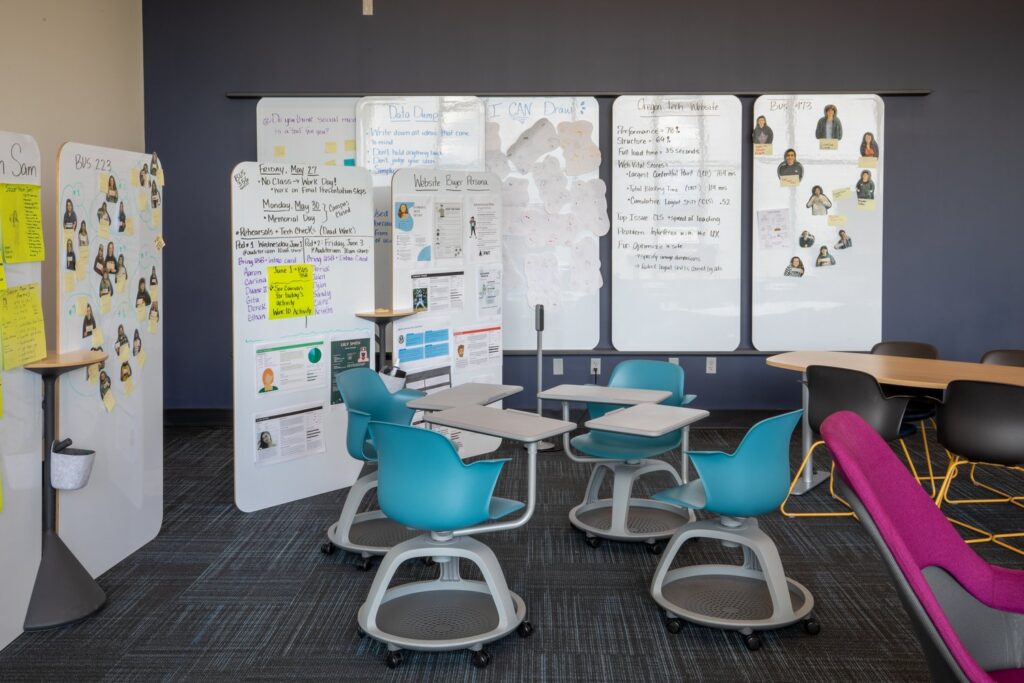How do educators prepare students to work in the innovative, dynamic, and evolving 21st century work environment when most of our classes are held in traditional front-facing classrooms designed for 20th century learning? This is the story of Oregon Tech’s journey to design and build an entrepreneurial classroom and lab to support the development of innovative skills among higher education students. This article shares the inspirations, design principles, pedagogy, and post-occupancy research to understand how the space supports students as they learn and apply innovation.
Inspiration
Oregon Tech is well known for its hands-on learning approach and several years ago, the Management faculty were in search of new ways to support the learning experiences for their students. Several of these faculty members attended Stanford’s d. school, well known for its design thinking training. Others spent time touring modern work and learning spaces. Their goal was to bring back what they learned to create a space that would support the infusion of design thinking within the Management curriculum. In 2017, their opportunity was realized when Oregon Tech secured funding to build the Center for Excellence in Engineering and Technology (CEET). An entrepreneurial space was selected to be one of its centerpieces.

Design
The design process began with a series of collaborative engagements between a small cross-disciplinary university team and the design firm, Hyphn. Conversations and discoveries centered around how the space would be used with core ideas focused on building a learning space as a mix of a modern workspace and collaborative classroom. Unlike many higher-education active learning classrooms that are mostly hard surfaces that allow for reconfiguration, this design included a wider variety of furnishings such as sofas, swivel chairs, and small writing surfaces paired with mobile hard surfaces. The room supports large groups, small groups, and individuals, with a range of postures, privacy, and seating options which promote individual control, choice, and comfort.
Post Occupancy Study
One of the main goals of the classroom design was to support the development of innovation competencies such as collaboration, communication, creativity, observation, risk-taking, dealing with ambiguity, and managing a project. To study this, the entrepreneurial lab was compared to the traditional classroom experience. Teachers in both types of classrooms utilized active learning pedagogy so that the researchers could uncover how each type of space supports innovation.

Students were asked a number of targeted questions regarding their experience in traditional classrooms and the entrepreneurial lab. These questions asked if the classroom:
- facilitates their ability to collaborate
- helps to communicate ideas with others
- supports creativity
- support the development of innovative idea creation
- help to take risks.
In all queried areas, the entrepreneurial classroom outperformed the experience in the traditional front-facing classrooms regarding the development of innovation-related activities. The entrepreneurial space design was far more successful in supporting the development of innovative skillsets in students.

Of great interest to researchers was the student feedback comparing the traditional and entrepreneurial space experience. In the traditional classroom, most students expressed that there was no impact on creativity. This was mainly due to being restricted to the rows which inhibited teamwork and discussion. Traditional classrooms were also referred to as uninspiring, uncomfortable, and the tools are limited to instructor use (figure 1).

Students also reflected on how the entrepreneurial lab supported creativity and innovation. Many students mentioned that the space was designed to allow for movement and openness. Several also mentioned the use of numerous writing surfaces to support idea-generation, brainstorming, and discussion within teams. They mentioned that the environment supported expression and interaction among their peers.
The study also showed the entrepreneurial space more effectively supported students in areas of student success such as feeling motivated and connecting with classmates. These areas of student support can help students perform better in the class, as well as over the long term, by feeling connected with the institution, instructor, and peers.

Innovative Learning Environment Model
Based on this research, and prior identification of innovative skills in the literature, the Innovative Learning Environment Model (figure 2) was developed and is presented as a framework to design learning spaces. The center area highlights five key areas of innovation skillsets that include the ability to work within a team, to manage complex projects in a highly ambiguous situation that require the ability to reflect, empathize, and collaborate.
Students shared the entrepreneurial space supported expression and interaction among their peers.
As discovered with this research, the most natural environment for this to occur is not within a traditional front-facing classroom. Therefore, this model has been developed to outline the key elements that are required to promote innovation in a learning space design. These elements include a variety of furniture to promote choice and movement, a host of writing surfaces and tools to iterate and manage project, technology designed to share work, and the development of a safe and supportive culture to encourage risk, collaboration, and reflection.
Based on the results of this work, the researchers are now in the process further applying the Innovative Learning Environment Model to learn how it can support learning environments that seek to optimize and promote the development of innovation skills for students at all levels.
- Project Team: Sharon Beaudry, Kristy Weidman, Sonja Bickford, Miranda Christophersen
- Design Firm: Hyphn, Portland Oregon.
- Case Study: Case Study: OIT CEET — Hyphn

